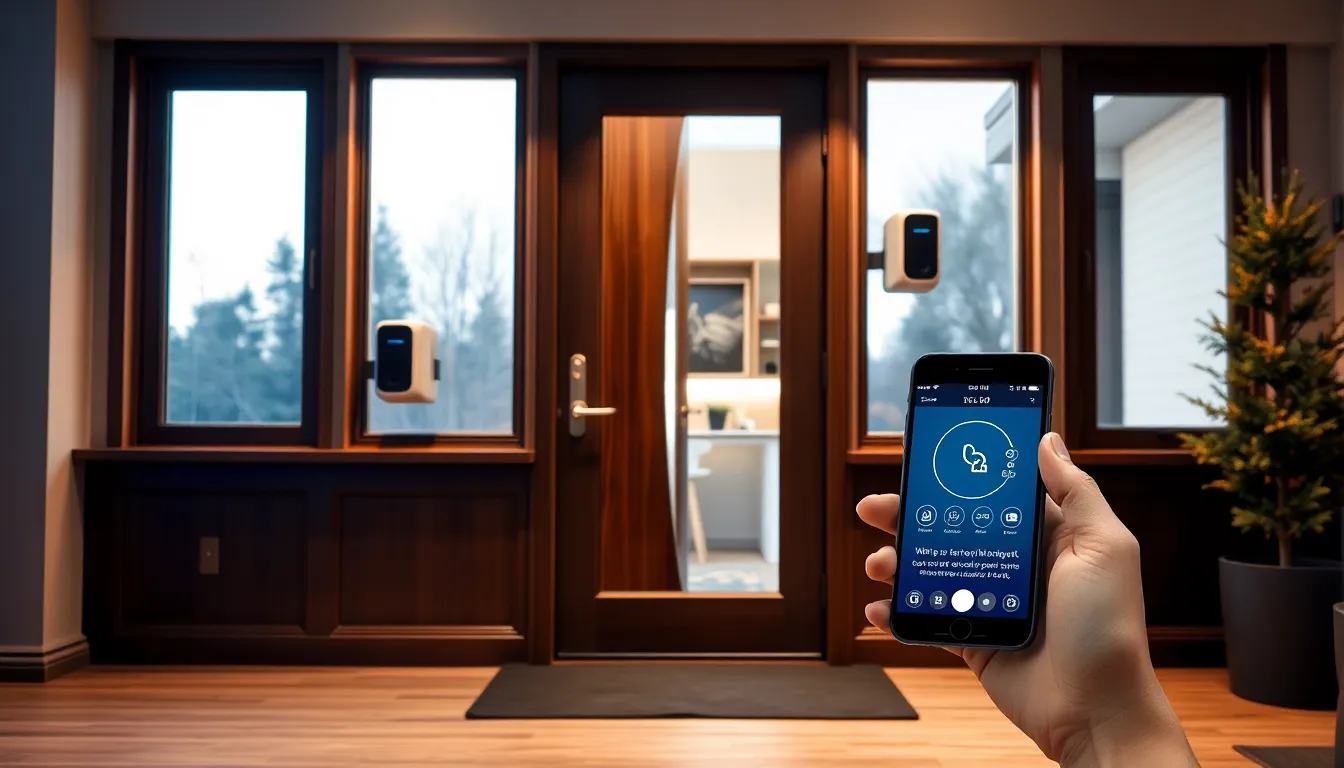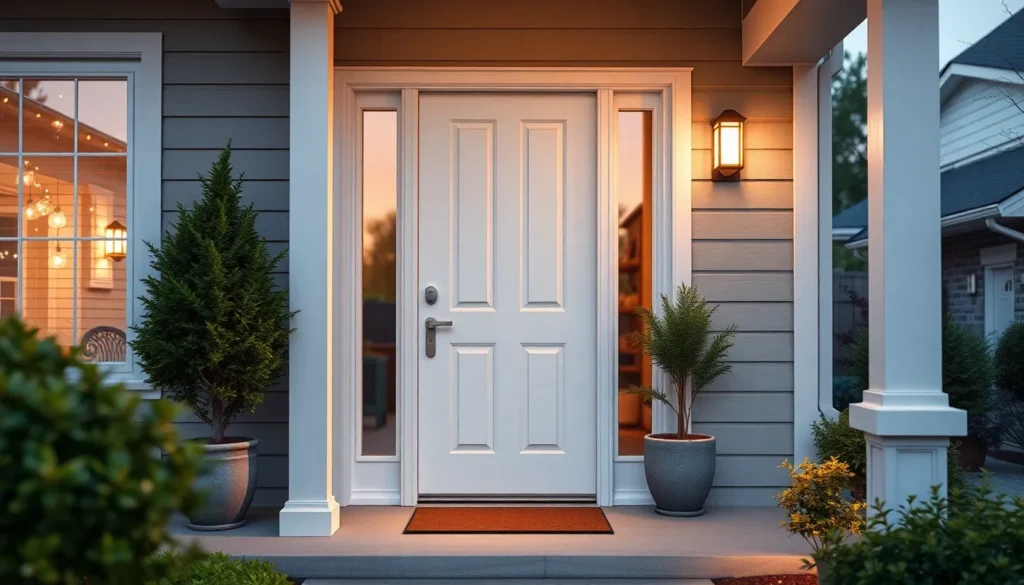Table of Contents
ToggleIn today’s fast-paced world, home security is more crucial than ever. Home entry sensors have emerged as a vital component in safeguarding personal spaces. These innovative devices not only provide peace of mind but also enhance the overall security of residences.
By detecting movement and monitoring entry points, home entry sensors act as the first line of defense against unauthorized access. With various types available, from door and window sensors to more advanced systems integrated with smart home technology, homeowners can tailor their security solutions to fit their needs. Understanding how these sensors work and their benefits can help anyone make informed decisions about home safety.
Overview Of Home Entry Sensors
Home entry sensors play a critical role in enhancing residential security by detecting unauthorized entry and monitoring movement. Understanding their functionality and types enables homeowners to select the right solutions for their security needs.
What Are Home Entry Sensors?
Home entry sensors are devices designed to detect movement at entry points, such as doors and windows. These sensors activate alerts when someone enters or exits, providing real-time information about access to the home. Many systems can connect to smartphones or security hubs, allowing homeowners to monitor their property remotely. These devices vary in technology, including motion, contact, and smart sensors, contributing to a comprehensive security strategy.
Types Of Home Entry Sensors
- Motion Sensors
Motion sensors detect movement within a specified area using infrared technology or microwave signals. They are typically placed near entry points, triggering alarms or notifications when movement occurs.
- Contact Sensors
Contact sensors consist of two components: a magnet and a switch. When the door or window opens, the magnet shifts, causing the switch to activate an alert. These sensors are reliable for monitoring access points.
- Smart Sensors
Smart sensors integrate with smart home systems, allowing homeowners to control and monitor entry points through mobile apps. These sensors can include video capabilities, providing visual confirmation of entries or exits.
- Glass Break Sensors
Glass break sensors detect the sound frequency of breaking glass. Strategically placed near windows, they add an extra layer of security by alerting homeowners of potential break-ins.
- Vibration Sensors
Vibration sensors respond to movement or impacts on doors or windows. They help identify unauthorized attempts to breach entry points and can notify homeowners immediately.
- Dual-Technology Sensors
Dual-technology sensors combine two detection methods, such as passive infrared and microwave technology. This dual approach minimizes false alarms by requiring confirmation from both detection methods before activating alerts.
Benefits Of Home Entry Sensors

Home entry sensors provide significant advantages for enhancing residential security and improving everyday convenience. These devices not only monitor entry points but also integrate seamlessly with smart home systems, offering a multifaceted approach to home safety.
Enhanced Security
Enhanced security represents one of the primary benefits of home entry sensors. These devices detect movement and unauthorized access, triggering alerts immediately. Homeowners receive notifications on their smartphones when sensors activate, allowing them to respond quickly. Sensors often integrate with cameras, providing video evidence of any breaches. Furthermore, systems can differentiate between pets and intruders, reducing false alarms. This advanced technology ensures comprehensive coverage across entry points, such as doors and windows, leading to a notable decrease in burglary attempts.
Convenience And Automation
Convenience and automation further enhance the appeal of home entry sensors. These devices can be programmed to interact with other smart home devices, streamlining daily routines. For instance, when a door opens, interior lighting can activate automatically, providing visibility during nighttime entries. Home entry sensors can also control thermostats, adjusting heating or cooling based on occupancy, leading to energy efficiency. Additionally, they enable remote monitoring, allowing homeowners to check entry status from anywhere. These features simplify home management, providing peace of mind and a tailored living experience.
Key Features To Consider
When selecting home entry sensors, key features significantly impact security effectiveness and user convenience. Understanding sensor types, connectivity options, and the installation process enables homeowners to choose the best solutions.
Sensor Types
Home entry sensors come in several types, each tailored for specific security needs.
- Motion Sensors detect movement within a designated area, valuable for monitoring larger spaces.
- Contact Sensors alert when doors or windows open, commonly used for entry points.
- Smart Sensors integrate with home automation systems, offering remote monitoring and control via smartphone apps.
- Glass Break Sensors detect the sound frequency of breaking glass, ideal for safeguarding windows.
- Vibration Sensors trigger alerts when they sense vibrations from forced entries, suitable for securing windows and doors.
- Dual-Technology Sensors combine multiple detection methods, reducing false alarms and improving reliability.
Connectivity Options
Connectivity plays a crucial role in the performance of home entry sensors.
- Wired Sensors provide stable connections, eliminating concerns about battery life; however, they require professional installation.
- Wireless Sensors offer flexibility and easier installation, often battery-operated, making them simple to relocate.
- Z-Wave and Zigbee Sensors foster integration with smart home ecosystems, enabling seamless communication between devices.
- Wi-Fi Sensors permit direct communication with smartphones, allowing real-time alerts and remote access via internet connections.
Installation Process
The installation process impacts efficiency and functionality.
- Professional Installation often ensures optimal placement and configuration, best for complex setups.
- DIY Installation suits most wireless models, typically involving simple mounting and pairing with a hub or app.
- Placement Considerations include positioning sensors at entry points, avoiding obstructions, and ensuring sensitivity to potential intrusions.
- Power Source must be considered; battery-operated sensors require regular maintenance, while wired options demand careful planning.
Each feature contributes to a comprehensive understanding of home entry sensors, enhancing overall security strategies.
Popular Home Entry Sensors On The Market
Several home entry sensors are available on the market, each offering unique features that enhance security and convenience. Understanding brand comparisons and user feedback assists homeowners in making informed choices.
Brand Comparisons
- Ring: Ring’s door sensors provide seamless integration with its video doorbells and security cameras. They offer real-time alerts and can be managed through their dedicated app.
- Nest: Nest Protect offers smart alarm functionalities alongside its home entry sensors. It features intelligent alerts and a sleek design that integrates well into smart home ecosystems.
- August: August Smart Lock sensors focus on securing doors with innovative keyless entry. Their sensors easily monitor door status and provide notifications via smartphone.
- SimpliSafe: SimpliSafe excels in affordability with user-friendly installation. Their sensors communicate through a dedicated hub, offering reliable monitoring and emergency alerts.
- Vivint: Vivint’s smart sensors provide advanced features like home automation. They include options for temperature control and light adjustments, enhancing overall home management.
User Reviews And Ratings
- Positive Feedback: Many users praise the effectiveness of Ring sensors in detecting intruders. Users frequently highlight alert reliability and user-friendly app interfaces.
- Negative Feedback: Some Nest Protect users report occasional false alarms, particularly with smoke detection. This inconsistency can lead to confusion during actual emergencies.
- Mixed Reviews: August tends to receive mixed feedback regarding installation ease. While some find the process straightforward, others encounter compatibility issues with older door systems.
- Overall Ratings: SimpliSafe consistently earns high ratings for its affordability and ease of use. Users often mention their satisfaction with the clarity of alerts and overall customer service support.
- Installation Experiences: Vivint enjoys favorable reviews for professional installations. However, DIY users often express a desire for clearer setup instructions in the manual.
Home entry sensors represent a vital component of modern home security. By understanding their functionality and the various types available, homeowners can effectively enhance their protection against unauthorized access. These devices not only provide real-time alerts but also integrate seamlessly with smart home systems for added convenience.
Choosing the right sensors tailored to specific needs can significantly improve overall security strategies. With options ranging from motion sensors to advanced smart sensors, homeowners have the tools necessary to create a safer living environment. Investing in reliable home entry sensors is a proactive step toward ensuring peace of mind in today’s ever-changing world.





